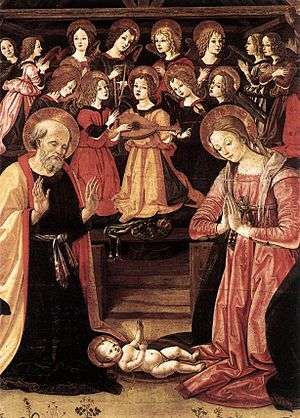Fiorenzo di Lorenzo
Fiorenzo di Lorenzo (c. 1440 – 1522) was an Italian painter, of the Umbrian school. He lived and worked at Perugia, where most of his authentic works are still preserved in the Galleria Nazionale dell'Umbria.[1]

Fiorenzo is known from a few signed works, including the Madonna of the Recommended (1476) and a niche with lunette, two wings and predella (1487), as well as from the documentary evidence that he was decemvir of that city in 1472, in which year he entered into a contract to paint an altarpiece for the church of Santa Maria Nuova, the pentatych of the Madonna and Saints.
Of his birth and death and pupilage nothing is known.[2] Renaissance art biographer Giorgio Vasari does not even mention Fiorenzo's name, though he probably refers to him when he says that Cristofano, Perugino's father, sent his son to be the shop drudge of a painter in Perugia, who was not particularly distinguished in his calling, but held the art in great veneration and highly honoured the men who excelled therein. Certain it is that the early works both of Perugino and of Pinturicchio show certain mannerisms which point towards Fiorenzo's influence, if not to his direct teaching.
The list of some fifty pictures which modern critics have ascribed to Fiorenzo includes works of such widely varied character that the scholars' suggestions of the masters under whom Fiorenzo is supposed to have studied varies. Pisanello, Verrocchio, Benozzo Gozzoli, Antonio Pollaiuolo, Benedetto Bonfigli, Andrea Mantegna, Francesco Squarcione, Filippo Lippi, Luca Signorelli and Domenico Ghirlandaio have all been mentioned.
According to the 1911 edition of the Encyclopædia Britannica:
Fiorenzo's authentic works are remarkable for their sense of space and for the expression of that peculiar clear, soft atmosphere which is so marked a feature in the work of Perugino. But Fiorenzo has an intensity of feeling and a power of expressing character which are far removed from the somewhat affected grace of Perugino. Of the forty-five pictures bearing Fiorenzo's name in the Pinacoteca of Perugia, the eight charming St Bernardino panels are so different from his well-authenticated works, so Florentine in conception and movement, that the Perugian's authorship is very questionable.
Notes
- Fiorenzo di Lorenzo, Umbria e Arte Archived 2013-03-15 at the Wayback Machine (in Italian)
- Hutton, Edward (1905). "Fiorenzo di Lorenzo". The cities of Umbria. Methuen. pp. 189–200.
References

| Wikimedia Commons has media related to Fiorenzo di Lorenzo. |